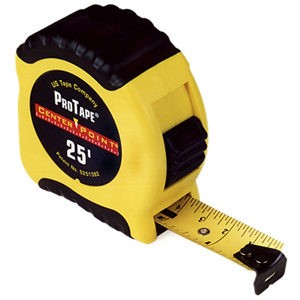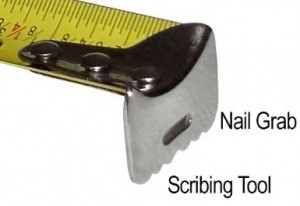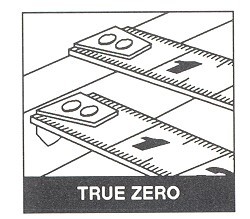Why Are Tape Measures Curved? Discover the ingenious design behind this essential tool with WHY.EDU.VN, exploring its curvature for enhanced rigidity and accuracy in measurements. Learn about additional features and unveil the utility of tape measures, and delve into related concepts such as measurement techniques and precision tools.
1. The Concave Curve: Functionality and Design
The slight curve you see in a tape measure’s blade isn’t a manufacturing defect; it’s a deliberate design element that significantly enhances the tool’s functionality. This concave shape provides essential rigidity, allowing the blade to extend further without collapsing under its own weight. It’s a simple yet effective solution to a common problem: how to take accurate measurements over longer distances without needing a second person to hold the tape.
1.1. How the Curve Works
The curve creates a resistance to bending, much like an arch in architecture. When the tape is extended, the curve distributes the force along the length of the blade, making it more stable. Without this curve, the tape would simply fold or droop, making it impossible to get an accurate reading.
1.2. Historical Context
The curved blade design wasn’t always a standard feature. Early tape measures were often flat and made of less rigid materials, limiting their reach and usability. The introduction of the concave blade marked a significant improvement, revolutionizing the way professionals and DIY enthusiasts alike could measure distances.
1.3. Materials and Manufacturing
The material used in the tape measure also plays a role in the effectiveness of the curve. High-quality steel is typically used, offering the right balance of flexibility and strength. The manufacturing process involves shaping the steel into the precise concave form and then heat-treating it to maintain its shape and durability.
1.4. Practical Applications
Consider a scenario where you’re measuring the width of a room by yourself. The curved blade allows you to extend the tape across the room, hook it onto the opposite wall, and read the measurement without the tape sagging or bending. This is especially useful for tasks like:
- Interior design and layout planning.
- Construction and carpentry projects.
- Home improvement and renovation work.
- Landscaping and outdoor measurements.
1.5. Comparing Flat vs. Curved Blades
| Feature | Flat Blade | Curved Blade |
|---|---|---|
| Rigidity | Low | High |
| Reach | Limited | Extended |
| Accuracy | Lower | Higher |
| Ease of Use | Requires Support for Length | Self-Supporting for Length |
| Best For | Short Distances | Long Distances |



1.6. The Science of Concavity
The concavity of a tape measure blade is a testament to applied physics. The principle at play is similar to that found in curved bridges and other structures where strength is derived from shape. The curve redirects force along the material, providing increased resistance to bending.
1.7. Expert Insights
According to engineers at WHY.EDU.VN, “The curved design optimizes the strength-to-weight ratio, allowing the tape to be lightweight while maintaining sufficient rigidity for most measuring tasks.” This insight highlights the thoughtful engineering that goes into even seemingly simple tools.
2. Beyond the Curve: Hidden Features of Tape Measures
While the curve is a prominent feature, tape measures are packed with other clever designs that enhance their functionality. These hidden features are often overlooked but can be incredibly useful in various situations.
2.1. The Adjustable End Hook
The metal hook at the end of the tape measure isn’t fixed in place. It’s designed to move slightly, compensating for its own thickness when measuring inside or outside corners.
2.1.1. True Zero Functionality
When measuring an external dimension, the hook moves outward, ensuring the measurement starts at zero. Conversely, when measuring an internal dimension, the hook moves inward, adding its thickness to the measurement. This “true zero” feature ensures accuracy regardless of the measuring method.
2.1.2. How It Works
The hook is typically attached with rivets that allow for slight movement. The amount of movement is precisely calibrated to match the thickness of the hook, ensuring accurate compensation.
2.2. The Nail Grab
Many tape measures include a small slot or notch on the end hook, designed to grip onto nails or screws. This feature is particularly useful when working alone, as it allows you to secure the tape measure while taking measurements.
2.2.1. Hands-Free Measuring
By hooking the tape onto a nail, you free up both hands to mark measurements or hold materials in place. This is especially helpful for tasks that require precision or when working in awkward positions.
2.3. The Serrated Edge
Some tape measures feature a serrated edge on the bottom of the end hook. This edge can be used as a makeshift marking tool, allowing you to score lines on surfaces without needing a pencil or pen.
2.3.1. Emergency Marking
While not as precise as a dedicated marking tool, the serrated edge can be a lifesaver when you need to make a quick mark and don’t have anything else available.
2.4. Special Markings
Certain tape measures include specific markings for common construction measurements, such as stud spacing or drywall lengths. These markings can save time and reduce the risk of errors when working on building projects.
2.4.1. I-Beam Spacing
For example, the black diamonds found every 19 3/16 inches on some metal tape measures are for spacing I-beam “timbers”.
2.5. Belt Clip
A simple but often overlooked feature is the belt clip. This allows you to keep the tape measure readily accessible while working, without having to constantly reach into your toolbox.
2.6. Magnetic Tip
Some high-end tape measures include a magnetic tip on the end hook. This allows you to easily attach the tape to metal surfaces, making it ideal for working with steel studs or other metal components.
2.7. Wider Blade
A wider blade provides greater stability and reach, especially when measuring longer distances. These tape measures are often preferred by professionals who need to take accurate measurements quickly and efficiently.
2.8. Dual Sided Printing
Some tape measures have measurements printed on both sides of the blade. This allows for easier reading in various positions and angles.
3. Accuracy and Precision: How Tape Measures Ensure Reliable Measurements
The accuracy of a tape measure is crucial for ensuring the success of any project, from simple home repairs to complex construction jobs. Several factors contribute to the overall precision of these tools.
3.1. Calibration Standards
Reputable tape measure manufacturers adhere to strict calibration standards to ensure their products meet specific accuracy requirements. These standards are often based on national or international measurement standards.
3.1.1. National Institute of Standards and Technology (NIST)
In the United States, NIST plays a key role in developing and maintaining measurement standards. Tape measure manufacturers often calibrate their equipment against NIST-traceable standards.
3.2. Blade Material and Thickness
The material and thickness of the blade affect its stability and resistance to stretching or bending. High-quality steel blades are less likely to deform, ensuring more accurate measurements over time.
3.3. Printing Accuracy
The accuracy of the printed markings on the blade is also critical. Manufacturers use precise printing techniques to ensure the markings are correctly positioned and easy to read.
3.4. Environmental Factors
Temperature and humidity can affect the accuracy of a tape measure, especially over longer distances. Extreme temperatures can cause the blade to expand or contract, while high humidity can lead to corrosion or rust.
3.4.1. Best Practices
To minimize the impact of environmental factors, it’s best to store tape measures in a cool, dry place and avoid using them in extreme temperatures.
3.5. User Technique
Even the most accurate tape measure can produce errors if not used correctly. Proper technique is essential for obtaining reliable measurements.
3.5.1. Common Mistakes
- Not pulling the tape taut.
- Allowing the tape to sag or bend.
- Reading the measurement at an angle.
- Not accounting for the thickness of the hook.
3.6. Maintaining Accuracy
Regularly inspect your tape measure for signs of damage or wear, such as kinks, bends, or faded markings. Replace the tape measure if it’s no longer accurate.
3.7. Digital Tape Measures
Digital tape measures offer even greater accuracy and precision, thanks to their electronic measuring systems. These tools can provide measurements to the nearest millimeter or even finer increments.
3.8. Laser Measures
Laser measures use a laser beam to determine distances, offering highly accurate measurements over long distances. These tools are ideal for tasks such as measuring room dimensions or calculating square footage.
3.9. Expert Opinion
“Accuracy is paramount when it comes to tape measures,” says a tool expert at WHY.EDU.VN. “A small error can have significant consequences, especially in construction or manufacturing.”
4. Choosing the Right Tape Measure: A Comprehensive Guide
With so many different tape measures available, it can be challenging to choose the right one for your needs. Here’s a comprehensive guide to help you make an informed decision.
4.1. Length
Tape measures come in various lengths, ranging from small pocket-sized models to long-distance reels. Consider the types of projects you’ll be working on and choose a length that’s appropriate for those tasks.
4.1.1. Common Lengths
- 12 feet: Ideal for small home repairs and DIY projects.
- 25 feet: A versatile option suitable for most general-purpose measuring tasks.
- 100 feet: Best for landscaping, construction, and other long-distance measurements.
4.2. Blade Material
The blade material affects the tape measure’s durability and resistance to wear and tear. Steel blades are the most common, offering a good balance of strength and flexibility.
4.2.1. Other Materials
- Fiberglass: Lightweight and non-conductive, ideal for electrical work.
- Cloth: Flexible and easy to handle, best for sewing and other fabric-related tasks.
4.3. Blade Width
A wider blade provides greater stability and reach, making it easier to take accurate measurements over longer distances.
4.3.1. Common Widths
- 1 inch: A standard width suitable for most general-purpose measuring tasks.
- 1 1/4 inches: Offers greater stability and reach compared to a 1-inch blade.
- Wider blades: Designed for heavy-duty use and long-distance measurements.
4.4. Case Material
The case material affects the tape measure’s durability and resistance to impact. Plastic cases are lightweight and affordable, while metal cases offer greater protection.
4.4.1. Common Materials
- ABS plastic: A durable and impact-resistant plastic commonly used in tape measure cases.
- Aluminum: Lightweight and corrosion-resistant, ideal for harsh environments.
- Steel: Provides maximum protection against impact and wear.
4.5. Features
Consider the features that are most important to you, such as a magnetic tip, belt clip, or dual-sided printing.
4.6. Brand Reputation
Choose a tape measure from a reputable brand known for quality and accuracy.
4.7. Price
Tape measures range in price from affordable to high-end. Set a budget and choose a tape measure that offers the best value for your money.
4.8. Intended Use
Consider the type of work you’ll be doing. A carpenter might need a durable tape measure with fractional markings, while a seamstress might prefer a flexible cloth tape.
4.9. Blade Coating
A protective coating can extend the life of the blade by resisting rust and abrasion.
4.10. Retraction Mechanism
A smooth, reliable retraction mechanism is essential for ease of use.
5. Advanced Measuring Techniques: Tips and Tricks for Accurate Results
Mastering advanced measuring techniques can significantly improve the accuracy and efficiency of your work. Here are some tips and tricks to help you get the most out of your tape measure.
5.1. Measuring Inside Corners
When measuring inside corners, use the “true zero” feature of the end hook to compensate for its thickness.
5.2. Measuring Outside Corners
When measuring outside corners, make sure the end hook is flush against the edge of the surface.
5.3. Measuring Curves
To measure curves, use a flexible tape measure or a piece of string. Mark the string at the beginning and end of the curve, then measure the length of the string.
5.4. Transferring Measurements
Use a combination square or T-bevel to accurately transfer measurements from one surface to another.
5.5. Using a Laser Level
A laser level can help you establish a level line across a room or surface, making it easier to take accurate measurements.
5.6. Taking Multiple Measurements
To ensure accuracy, take multiple measurements and average the results.
5.7. Avoiding Parallax Error
When reading the tape measure, position your eye directly above the measurement to avoid parallax error.
5.8. Using a Story Pole
For repetitive measurements, create a story pole with the desired measurements marked on it.
5.9. Measuring with Assistance
When possible, have someone assist you with taking measurements, especially over long distances.
5.10. Understanding Metric and Imperial
Be familiar with both metric and imperial units and how to convert between them.
6. The Evolution of Tape Measures: From Ancient Times to Modern Technology
The tape measure has a rich history, evolving from simple tools used in ancient times to the sophisticated instruments we use today.
6.1. Ancient Origins
Early forms of measurement devices date back to ancient civilizations, such as the Egyptians and Romans. These tools often consisted of marked ropes or rods used for surveying and construction.
6.2. The Chain of Gunter
In the 17th century, Edmund Gunter invented the “chain of Gunter,” a 66-foot-long chain used for surveying land. This chain became a standard tool for land measurement and played a key role in the development of modern surveying techniques.
6.3. The Steel Tape Measure
The invention of the steel tape measure in the 19th century marked a significant improvement in accuracy and durability. These tape measures were more resistant to stretching and wear compared to their predecessors.
6.4. The Spring-Loaded Retractable Tape Measure
The spring-loaded retractable tape measure, patented by James Chesterman in 1829, revolutionized the way measurements were taken. This design allowed for easy extension and retraction of the blade, making it more convenient to use.
6.5. Modern Innovations
Today’s tape measures incorporate a variety of advanced features, such as digital displays, laser measurement technology, and Bluetooth connectivity. These innovations have further enhanced the accuracy, efficiency, and versatility of tape measures.
6.6. The Future of Tape Measures
The future of tape measures is likely to involve even more sophisticated technology, such as augmented reality and artificial intelligence. These advancements could enable users to take measurements with even greater accuracy and ease.
6.7. Notable Milestones
| Year | Milestone |
|---|---|
| Ancient | Marked ropes and rods used for measurement |
| 17th C | Edmund Gunter invents the chain of Gunter |
| 19th C | Steel tape measures introduced |
| 1829 | Spring-loaded tape measure patented |
| Today | Digital and laser tape measures available |
7. Common Mistakes to Avoid When Using a Tape Measure
Even experienced users can make mistakes when using a tape measure. Here are some common errors to avoid.
7.1. Not Pulling the Tape Taut
Failing to pull the tape taut can result in inaccurate measurements due to sagging or bending.
7.2. Allowing the Tape to Sag or Bend
Allowing the tape to sag or bend can also lead to inaccurate measurements, especially over longer distances.
7.3. Reading the Measurement at an Angle
Reading the measurement at an angle can cause parallax error, resulting in an inaccurate reading.
7.4. Not Accounting for the Thickness of the Hook
Failing to account for the thickness of the end hook when measuring inside corners can lead to errors.
7.5. Using a Damaged Tape Measure
Using a tape measure that is damaged or worn can compromise its accuracy.
7.6. Mixing Up Units
Mixing up metric and imperial units can lead to significant errors.
7.7. Measuring Over Obstructions
Measuring over obstructions can result in inaccurate measurements.
7.8. Not Checking Calibration
Failing to check the calibration of the tape measure can lead to errors over time.
7.9. Measuring in Extreme Temperatures
Measuring in extreme temperatures can affect the accuracy of the tape measure.
7.10. Forgetting to Lock the Blade
Forgetting to lock the blade in place can cause it to retract unexpectedly, resulting in an inaccurate measurement.
8. Tape Measure Maintenance: Ensuring Longevity and Accuracy
Proper maintenance is essential for ensuring the longevity and accuracy of your tape measure. Here are some tips for keeping your tape measure in top condition.
8.1. Cleaning the Blade
Regularly clean the blade with a dry cloth to remove dirt, dust, and debris.
8.2. Lubricating the Retraction Mechanism
Lubricate the retraction mechanism with a silicone-based lubricant to keep it working smoothly.
8.3. Storing the Tape Measure Properly
Store the tape measure in a cool, dry place to prevent rust and corrosion.
8.4. Avoiding Extreme Temperatures
Avoid exposing the tape measure to extreme temperatures, which can affect its accuracy.
8.5. Inspecting for Damage
Regularly inspect the tape measure for signs of damage, such as kinks, bends, or faded markings.
8.6. Replacing Worn Parts
Replace worn parts, such as the end hook or retraction spring, as needed.
8.7. Calibrating the Tape Measure
Calibrate the tape measure periodically to ensure its accuracy.
8.8. Protecting the Blade
Protect the blade from scratches and abrasions by using a blade protector.
8.9. Drying After Use
Dry the tape measure thoroughly after using it in wet conditions.
8.10. Using a Case
Store the tape measure in a case to protect it from impact and wear.
9. The Tape Measure in Different Professions: Tailored Tools for Specific Needs
Different professions require different types of tape measures, each tailored to specific needs and tasks.
9.1. Construction Workers
Construction workers typically use durable steel tape measures with fractional markings and long lengths.
9.2. Carpenters
Carpenters often prefer tape measures with a wide blade, fractional markings, and a magnetic tip.
9.3. Electricians
Electricians require non-conductive fiberglass tape measures for safety purposes.
9.4. Plumbers
Plumbers often use flexible tape measures for measuring pipes and fittings.
9.5. Surveyors
Surveyors rely on long-distance tape measures with precise markings for land measurement.
9.6. Seamstresses
Seamstresses use flexible cloth tape measures for taking body measurements and marking fabrics.
9.7. Interior Designers
Interior designers often use laser tape measures for measuring room dimensions and calculating square footage.
9.8. Landscapers
Landscapers require long tape measures for measuring garden beds, lawns and other outdoor areas.
9.9. DIY Enthusiasts
DIY enthusiasts typically use versatile tape measures with standard features for home improvement projects.
9.10. Engineers
Engineers demand high-precision tape measures for designs and projects that require extreme accuracy.
10. Frequently Asked Questions (FAQs) About Tape Measures
Here are some frequently asked questions about tape measures.
10.1. Why is my tape measure curved?
The curve provides rigidity, allowing the blade to extend further without collapsing.
10.2. What is the purpose of the adjustable end hook?
It compensates for its own thickness when measuring inside or outside corners.
10.3. How do I measure an inside corner accurately?
Use the “true zero” feature of the end hook.
10.4. How do I clean my tape measure?
Wipe the blade with a dry cloth.
10.5. What is the best tape measure for construction work?
A durable steel tape measure with fractional markings and a long length.
10.6. How do I calibrate my tape measure?
Compare it to a known standard and adjust if necessary.
10.7. What are the black diamonds on some tape measures for?
They are for spacing I-beam “timbers”.
10.8. How do I measure a curve with a tape measure?
Use a flexible tape measure or a piece of string.
10.9. How long does a tape measure typically last?
With proper care, a high-quality tape measure can last for many years.
10.10. Can I use a tape measure for electrical work?
Use a non-conductive fiberglass tape measure for safety.
Seeking precise answers to your burning questions? Look no further than WHY.EDU.VN, your ultimate resource for expert knowledge. From understanding the curvature of tape measures to mastering advanced measuring techniques, we’ve got you covered.
Still curious? Our team of specialists is ready to provide you with tailored insights and solutions. Don’t hesitate to connect with us at 101 Curiosity Lane, Answer Town, CA 90210, United States, or give us a call on Whatsapp: +1 (213) 555-0101. Explore our extensive database of articles and FAQs at why.edu.vn and unlock a world of knowledge today. Your quest for answers starts here.]

